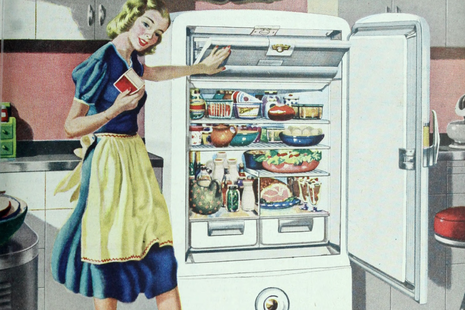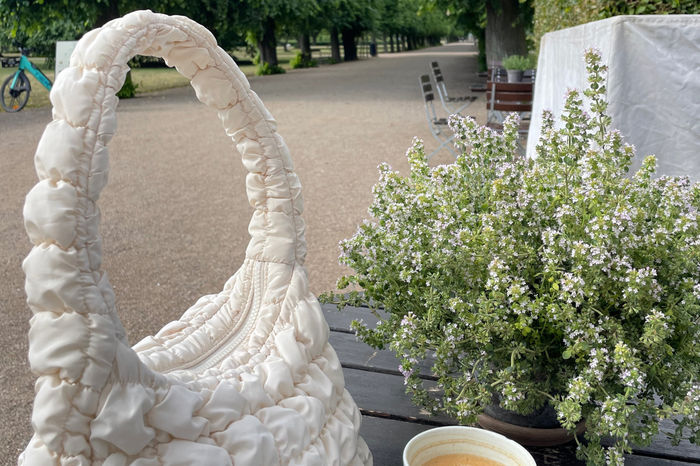The right look: dressing up conservatism
Niamh Walters explores how the tradwife aesthetic dresses up a conservative ideology

The re-election of Donald Trump in 2024 seemed founded on rhetoric of the Heritage Foundation’s Project 2025 manifesto: calling for the maintenance of a ‘biblically based, social science-reinforced definition of marriage and family’ and a crackdown on ‘woke ideology’. Indeed, far-right parties garnered nearly 25% of the vote in the European Parliament election (Mudde, 2024), while the recent German election saw the Alternative for Germany (AfD) party double its vote share since 2021 (Robbins, 2025). In this political climate, debates over reproductive rights and the importance of ‘traditional values’ are actively shaping election discourse, culture, and policy.
At this point, you might be double-checking that you’re in the right Varsity section. This is supposed to be a fashion piece, right? I wanted some fashion tips on dressing cute during this mini heatwave (you and me both), not to be reminded about the depressingly tumultuous state of world politics at the moment.
But here’s the thing: fashion is, and always has been, political. From Dior’s iconic New Look, reflecting a post-war resurgence in traditionalism, to the bold and vibrant mod fashion of the 1960s and 1970s, which rejected conservative norms, fashion has consistently served as a visual embodiment of political and cultural tensions. It therefore seems natural that a resurgence in conservatism and a nostalgia for a former golden era, a time when America used to be ‘great’, has trickled down through algorithms and fashion houses to produce the ‘tradwife’ look.
“The prairie dress becomes more than a cute outfit; it becomes an ideological and post-feminist symbol”
Characterised by flowing prairie dresses and skirts, lace collars, gingham tops and nipped waists, the ‘tradwife’ is often found wistfully baking sourdough bread while revelling in domestic picket-fence bliss, echoing a bygone 1950s fantasy of the ideal housewife. Crucially, however, the trad wife does not automatically equate to a stay-at-home mum, with the former distinctly shaped by a specific conservative ideology and performative aesthetic that depicts women as natural homemakers. Self-proclaimed tradwife influencer Estee Williams clarifies the stance that ‘tradwives should submit to their husbands and serve their husbands and family’, a message often portrayed through the equation of ‘femininity’ with submission and financial dependence.
Reflected in the emphasis on traditional and hyper-feminine 50s silhouettes, the ‘tradwife’ aesthetic temporally and stylistically deviates from the ‘girlboss’ corporate style that embodied women’s increasing participation in the workforce and egalitarian relationships in light of feminist progress.
Rather than merely reflecting the past, however, these trends are firmly rooted in contemporary crises, with increasing economic precarity, escalating political conflicts, and ecological insecurity in light of climate change fueling a general disillusionment with the promises of prosperity sold by neoliberalism. Faced with astronomical childcare bills, limited or no maternity pay in countries such as the US, and gender-based workplace discrimination, young women are evidently becoming increasingly disillusioned with careerism and consumption, which were initially presented as a form of liberation. One in three women now experiences depression, with 54% citing work and financial pressures as key contributing factors.
In contrast, the promise of slow living, economic security and domesticity certainly offers a compelling fantasy. However, this fantasy, rooted in nostalgia, is not neutral. For one, the tradwife is ‘almost unilaterally white and affluent’, presenting an image of femininity that is invariably white, heterosexual, and middle class. The glorification of the 1950s and the housewife ideal not only obscures the systematic racial, economic and gendered oppression during this period but also relies on the fantasy of a single-income household that was (and still is) economically inaccessible for working-class women and, in particular, women of colour.
The question of class, therefore, also complicates how the tradwife presents herself. While figures such as Nara Smith arguably reject ‘the typical uniform of prairie dresses for a more chic aesthetic and layers of gold jewellery’, her flamboyant take on the tradwife aesthetic diverts from modesty and nostalgia in favour of a display of wealth and luxury – notably including one video where Smith wears a $2,990 dress while making cough drops. In this light, while the tradwife is not a monolith, the underlying message persists: femininity is defined through service, softness and domesticity; bound by the constant need to be beautiful, even when you’re making your children Cheez-its from scratch.
“Femininity is defined through service, softness and domesticity; bound by the constant need to be beautiful, even when you’re making your children Cheez-its from scratch”
Despite these undertones, the soft, hyper-feminine aesthetic plays perfectly to the visual logic of TikTok and YouTube, functioning as a viable currency in the spread and legitimisation of ideology. An initial apolitical emphasis on feminine fashion, therefore, can enable right-wing influence to initially appeal to mainstream audiences while simultaneously establishing algorithmic linkages with more far-right content (Zahay, 2022). In this context, the prairie dress becomes more than a cute outfit; it becomes an ideological and post-feminist symbol, one that rejects feminist visions of empowerment rooted in equality and the dismantling of patriarchal structures, in favour of a version that places domesticity and personal choice above all else.
While the tradwife aesthetic may appear innocuous or even aspirational, its rise reflects a broader cultural and political shift. In periods of instability, long skirts and feminine silhouettes echo a nostalgia for a bygone ‘simpler’ era. Fashion trends, notably, don’t exist in a vacuum, but can constitute visual mood boards for our society. Indeed, how we choose to dress can be the ultimate form of self-expression and a reflection of personal preference; yet, viewing fashion solely through the lens of personal choice risks obscuring how fashion items can embody and often act as uniforms for broader political and ideological projects that dictate who can wear what. While we absolutely need to interrogate the politics we support and vote for, we equally must critically consider the content we consume and the aesthetics we engage with. In the age of aesthetic populism and algorithmic radicalisation, even a gingham apron can become a Trojan horse.
 Comment / Plastic pubs: the problem with Cambridge alehouses 5 January 2026
Comment / Plastic pubs: the problem with Cambridge alehouses 5 January 2026 News / Cambridge academics stand out in King’s 2026 Honours List2 January 2026
News / Cambridge academics stand out in King’s 2026 Honours List2 January 2026 News / Cambridge businesses concerned infrastructure delays will hurt growth5 January 2026
News / Cambridge businesses concerned infrastructure delays will hurt growth5 January 2026 News / AstraZeneca sues for £32 million over faulty construction at Cambridge Campus31 December 2025
News / AstraZeneca sues for £32 million over faulty construction at Cambridge Campus31 December 2025 Interviews / You don’t need to peak at Cambridge, says Robin Harding31 December 2025
Interviews / You don’t need to peak at Cambridge, says Robin Harding31 December 2025










